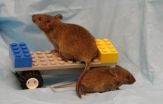(Press-News.org) Singapore, 15 September 2014—A small freshwater fish found in many tropical aquariums may hold the key to unlocking one of the leading causes of respiratory diseases in humans.
Scientists from A*STAR's Institute of Molecular and Cell Biology (IMCB) have identified hundreds of novel genes in the zebrafish that could be functionally identical to the human genes required for forming motile cilia, hair-like structures on the surface of airway cells. These are required for removing dust and pathogens from the human airway. The study showed that the loss of these genes is linked to development of defective motile cilia, which could be the cause of some respiratory diseases.
Primary Ciliary Dyskinesia (PCD) is a rare genetic disorder which results in defective motile cilia within the human airway. Defective motile cilia cannot function properly to remove dust and bacteria from the lungs, leading to a range of respiratory problems, including chronic lung infections such as bronchitis and pneumonia, and in more severe cases, causes long term damage to the airway.
Reported recently as a cover article in Development, a leading research journal in developmental biology, the IMCB research team identified hundreds of novel genes that are associated with the development of motile cilia via genetic screening in zebrafish. Out of nearly 600 genes found in the zebrafish, the researchers identified almost all of the 26 known genes responsible for PCD, implying that many more could be linked to the disorder.
Further studies on this discovery can yield useful information to pinpoint the genes associated with PCD. These genes may be valuable markers for the accurate diagnosis of PCD and other causes for defective motile cilia via genetic testing. This will in turn allow healthcare practitioners to implement mitigation strategies early.
"There is no cure for PCD. Doctors can only prescribe aggressive treatments to slow the progress of airway damage and address the respiratory issues resulting from PCD. It is therefore important to identify the genes responsible in a precise manner and diagnose the condition early," said Dr Sudipto Roy, Senior Principal Investigator at IMCB and the lead scientist for the study. "Our collection of genes will be invaluable for understanding how cilia are made and what cause them to be defective. They are important clues for understanding cilia-related diseases, and to develop future treatments," he added.
Professor Hong Wanjin, Executive Director of IMCB, said, "Developmental biology seeks to understand the basic principles governing the development of humans and how the emergence of complexities can be implicated in human diseases. This is exemplified in our study, which has uncovered the links between human diseases and the genes involved in cilia formation. Such foundational research is crucial as practical applications of research outcomes need to be grounded in fundamental science."
INFORMATION:
IMAGES
Image 1: Human airway cells produce hundreds of motile cilia. Cilia are labelled in green, cell membranes in red, and nuclei in blue.
Notes to Editor:
The research findings described in this media release can be found in the Development Journal, under the title, "Systematic discovery of novel ciliary genes through functional genomics in the zebrafish" by Semil P. Choksi1, Deepak Babu1,2, Doreen Lau1, Xianwen Yu1,* and Sudipto Roy1,2,3,4
1Institute of Molecular and Cell Biology, 61 Biopolis Drive, Singapore 138673;
2NUS Graduate School of Integrative Sciences and Engineering, Centre for Life Sciences, 28 Medical Drive, Singapore 117456;
3Department of Biological Sciences, National University of Singapore, 14 Science Drive 4, Singapore 117543;
4Department of Paediatrics, Yong Loo Lin School of Medicine, National University of Singapore,1E Kent Ridge Road, Singapore 119288;
*Present address: Department of Biological Sciences, Key Laboratory of the Ministry of Education for Cell Biology and Tumor Cell Engineering, School of Life Sciences, Xiamen University, Xiamen, Fujian 361005, China.
Full text of the Development paper can be accessed online from: http://dev.biologists.org/content/141/17/3410.full?sid=3e92ba95-1416-4e94-97a0-1180801d81da
For media queries and clarifications, please contact:
Tan Yun Yun
Senior Officer, Corporate Communications
Agency for Science, Technology and Research
Tel: +65 6826 6273
Email: tan_yun_yun@a-star.edu.sg
About the Institute of Molecular and Cell Biology (IMCB)
The Institute of Molecular and Cell Biology (IMCB) was launched on 23 January 1985, with its official opening ceremony held on 2 October 1987 at the National University of Singapore (NUS). It subsequently became an autonomous research institute (RI) of A*STAR, moving to Biopolis in 2004. IMCB's vision is to be a premier cell and molecular biology institute which addresses the mechanistic basis of human diseases and its mission is to conduct cutting-edge discovery research in disease pathways; to groom early career researchers to be future leaders in research; and to collaborate with medical and industry communities for research impact. IMCB plays an important role training and recruiting scientific talents, and has contributed to the development of other research entities in Singapore. Its success in fostering a biomedical research culture in Singapore has catalysed Singapore's transformation into an international hub for biomedical research, development and innovation.
Funded primarily by the Biomedical Research Council (BMRC) of A*STAR, IMCB's current discovery research includes cell biology in health and disease; animal models of development & disease; cancer & stem cell genetics & genomics; and structural biology & drug discovery. IMCB's translational research includes humanised model organisms for human diseases; systems approach for disease target identification & validation; and protein engineering & antibody development for diagnostics & therapeutics. Research activities in IMCB are supported by cutting edge infrastructure and facilities including quantitative proteomics; humanised mice; mouse models of human cancer; protein crystallography X-ray; zebrafish for drug metabolism & toxicology; advanced molecular histopathology; imaging & electron microscopy; and DNA sequencing.
For more information about IMCB, visit http://www.imcb.a-star.edu.sg.
About the Agency for Science, Technology and Research (A*STAR)
The Agency for Science, Technology and Research (A*STAR) is Singapore's lead public sector agency that fosters world-class scientific research and talent to drive economic growth and transform Singapore into a vibrant knowledge-based and innovation driven economy.
In line with its mission-oriented mandate, A*STAR spearheads research and development in fields that are essential to growing Singapore's manufacturing sector and catalysing new growth industries. A*STAR supports these economic clusters by providing intellectual, human and industrial capital to its partners in industry.
A*STAR oversees 18 biomedical sciences and physical sciences and engineering research entities, located in Biopolis and Fusionopolis, as well as their vicinity. These two R&D hubs house a bustling and diverse community of local and international research scientists and engineers from A*STAR's research entities as well as a growing number of corporate laboratories.
For more information on A*STAR, please visit http://www.a-star.edu.sg
Zebrafish genes linked to human respiratory diseases
A*STAR scientists have discovered genes in this tropical freshwater fish which may be synonymous with the genes for developing hair-like structures in the human airway
2014-09-15
ELSE PRESS RELEASES FROM THIS DATE:
Poor diet may increase risk of Parkinson's disease
2014-09-15
Obesity caused by a high-fat diet may increase the risk of developing Parkinson's disease, new research in mice suggests. Upon aging, a high-fat diet significantly accelerated the onset of neurological symptoms in mice that were genetically predisposed to develop Parkinson's disease.
The Journal of Neurochemistry findings suggest that in addition to having negative effects on glucose and insulin regulation in the body, an unhealthy diet may also cause damage in the brain. More research is needed to uncover the molecular and cellular mechanisms involved.
INFORMATION:
...
Tigers, pandas and people a recipe for conservation insight
2014-09-15
VIDEO:
Neil Carter and Vanessa Hull talk about what they've learned from the animals -- and people -- they study.
Click here for more information.
The first big revelation in conservation sciences was that studying the people on the scene as well as nature conservation was crucial. Now, as this science matures, researchers are showing that it's useful to compare apples and oranges.
Or, more accurately, tigers and pandas.
In this week's journal Ecology & Society, Michigan ...
Airborne particles beyond traffic fumes may affect asthma risk
2014-09-15
Researchers in Sydney and Newcastle, Australia have found that elements of dust, particularly those coarse particles that contain iron traces, stimulate the production of inflammatory molecules in cells from the airways of mice and healthy human volunteers. Surprisingly, traffic fume pollutants did not cause these changes. The findings are featured in a new Respirology study.
"These effects are likely to contribute to the development of asthma in childhood, as well as to worsening of asthma when pollution levels are high." said Dr. Rakesh Kumar, lead author of the study. ...
Cellular protein may be key to longevity
2014-09-15
Researchers have found that levels of a regulatory protein called ATF4, and the corresponding levels of the molecules whose expression it controls, are elevated in the livers of mice exposed to multiple interventions known increase longevity.
Elevation of ATF4, at least in the liver, seems to be a shared feature of diets, drugs, genes, and developmental alterations that extend maximum lifespan.
"Pathways that appear to change in the same way in many different kinds of slow-aging mice may provide helpful hints towards the design of drugs that keep people healthy longer ...
A thin line lies between fantasy and reality in people with psychopathic traits
2014-09-15
New research indicates that people with psychopathic traits have a preference for nonromantic sexual fantasies with anonymous and uncommitted partners. The study's investigators noted that psychopathic sexual behavior is likely due to a preference for sexual activity outside a loving, committed relationship rather than only an inability to form such relationships.
Individuals with deviant sexual preferences and normal levels of empathy, kindness, and self-control have many strategies for satisfying their needs, including negotiation, compromise, and restraint; however, ...
Run, cheetah, run
2014-09-15
CAMBRIDGE, MA -- Speed and agility are hallmarks of the cheetah: The big predator is the fastest land animal on Earth, able to accelerate to 60 mph in just a few seconds. As it ramps up to top speed, a cheetah pumps its legs in tandem, bounding until it reaches a full gallop.
Now MIT researchers have developed an algorithm for bounding that they've successfully implemented in a robotic cheetah — a sleek, four-legged assemblage of gears, batteries, and electric motors that weighs about as much as its feline counterpart. The team recently took the robot for a test run on ...
How a change in slope affects lava flows
2014-09-15
As soon as lava flows from a volcano, exposure to air and wind causes it to start to cool and harden. Rather than hardening evenly, the energy exchange tends to take place primarily at the surface. The cooling causes a crust to form on the outer edges of the lava flow, insulating the molten lava within. This hardened lava shell allows a lava flow to travel much further than it would otherwise, while cracks in the lava's crust can cause it to draw up short.
When there is a break in the terrain—a sharp change in slope, a valley, or a rock wall, for example—the smooth lava ...
Predicting prostate cancer: Pitt-developed test identifies new methods for treatment
2014-09-15
PITTSBURGH, Sept. 15, 2014 – A genetic discovery out of the University of Pittsburgh School of Medicine is leading to a highly accurate test for aggressive prostate cancer and identifies new avenues for treatment.
The analysis, published today in the American Journal of Pathology, found that prostate cancer patients who carry certain genetic mutations have a 91 percent chance of their cancer recurring. This research was funded by the National Institutes of Health (NIH), American Cancer Society and University of Pittsburgh Cancer Institute (UPCI).
"Being able to say, ...
Scientists identify the master regulator of cells' heat shock response
2014-09-15
Heat shock proteins protect the molecules in all human and animal cells with factors that regulate their production and work as thermostats. In new research published Sept. 16 in the journal eLife, scientists at NYU Langone Medical Center and elsewhere report for the first time that a protein called translation elongation factor eEF1A1 orchestrates the entire process of the heart shock response. By doing so, eEF1A1 supports overall protein homeostasis inside the cell, ensuring that it functions properly under various internal and external stress conditions. The researchers ...
Research offers new way to predict hurricane strength, destruction
2014-09-15
TALLAHASSEE, Fla. — A new study by Florida State University researchers demonstrates a different way of projecting a hurricane's strength and intensity that could give the public a better idea of a storm's potential for destruction.
Vasu Misra, associate professor of meteorology and co-director of the Florida Climate Institute, and fourth-year doctoral student Michael Kozar introduce in the Monthly Weather Review of the American Meteorological Society a new statistical model that complements hurricane forecasting by showing the size of storms, not just the wind speed.
The ...
LAST 30 PRESS RELEASES:
Scalable and healable gradient textiles for multi‑scenario radiative cooling via bicomponent blow spinning
Research shows informed traders never let a good climate crisis go to waste
Intelligent XGBoost framework enhances asphalt pavement skid resistance assessment
Dual-function biomaterials for postoperative osteosarcoma: Tumor suppression and bone regeneration
New framework reveals where transport emissions concentrate in Singapore
NTP-enhanced lattice oxygen activation in Ce-Co catalysts for low-temperature soot combustion
Synergistic interface engineering in Cu-Zn-Ce catalysts for efficient CO2 hydrogenation to methanol
COVID-19 leaves a lasting mark on the human brain
Scientists use ultrasound to soften and treat cancer tumors without damaging healthy tissue
Community swimming program for Black youth boosts skills, sense of belonging, study finds
Specific depressive symptoms in midlife linked to increased dementia risk
An ‘illuminating’ design sheds light on cholesterol
Who is more likely to get long COVID?
Study showcases resilience and rapid growth of “living rocks”
Naval Research Lab diver earns Office of Naval Research 2025 Sailor of the Year
New Mayo-led study establishes practical definition for rapidly progressive dementia
Fossil fuel industry’s “climate false solutions” reinforce its power and aggravate environmental injustice
Researchers reveal bias in a widely used measure of algorithm performance
Alcohol causes cancer. A study from IOCB Prague confirms damage to DNA and shows how cells defend against it
Hidden viruses in wastewater treatment may shape public health risks, study finds
Unlock the power of nature: how biomass can transform climate mitigation
Biochar reshapes hidden soil microbes that capture carbon dioxide in farmland
Reducing saturated fat intake shows mortality benefit, but only in high-risk individuals
Manta rays create mobile ecosystems, study finds
Study: Mixed results in using lipoic acid to treat progressive multiple sclerosis
Norbert Holtkamp appointed director of Fermi National Accelerator Laboratory
New agentic AI platform accelerates advanced optics design
Biologists discover neurons use physical signals — not electricity — to stabilize communication
Researchers discover that a hormone can access the brain by hitchhiking
University of Oklahoma researcher awarded funding to pursue AI-powered material design
[Press-News.org] Zebrafish genes linked to human respiratory diseasesA*STAR scientists have discovered genes in this tropical freshwater fish which may be synonymous with the genes for developing hair-like structures in the human airway




